I’m super excited to announce I’ve launched a Citizen Science project to learn more about the animal enemies of mushrooms in the genus Amanita, especially my study species Amanita phalloides. You can enter data for the project on iNaturalist, here.
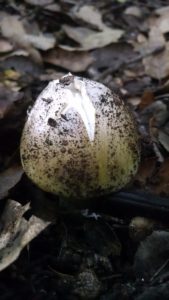
A young Phalloides emerges from the soil at Point Reyes National Seashore.
If the word limit there leaves you yearning for more background on why we launched the project or how to collect data, read on!
Project background:
Once native only to Europe, the toxic mushroom, Amanita phalloides was accidentally spread around the world when people planted European plants in other locations. At the time, people didn’t realize the soil they brought with the plants harbored a myriad of microbes. The death cap mushroom can now be found on the west and east coasts of North America, in several countries in South America, in South Africa, and in Australia. It has been reported from Asia as well, though those reports may actually refer to similar appearing poisonous species in the genus Amanita.
Amanita phalloides is a particularly interesting invasive fungus since it is mycorrhizal, meaning it forms a mutually beneficial relationship with its host trees. The tree provides sugar it makes from photosynthesis, and in exchange the fungus trades water, nutrients, and minerals.
-

A diagram of the mycorrhizal symbiosis from Anders Dahlberg.
A. phalloides is rich in two main groups of toxins. Amatoxins can inhibit and kill Eukaryotes like insects and other fungi by binding to RNA polymerase II, a protein that makes other proteins. Secondly, a group of toxins called Phallotoxins can harm Prokaryotes like blue green algae, as well as bacteria that have Eukaryote-like actin, a protein important for cell structure. The death cap is notorious for killing humans that have mistaken it for other edible species, but the ecological role of the toxins in the natural world remains unclear.
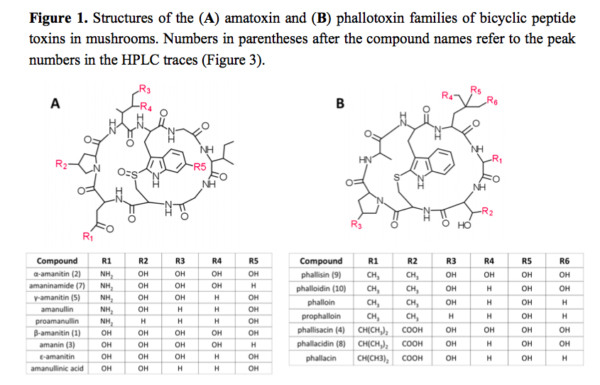
It may be that the primary targets of the toxins are microbes. To explore that possibility, Cat has been collecting fresh mushroom samples to study the bacteria and viruses inside the mushroom.
But to study whether the toxins might also protect Phalloides from insects, we’re calling on you, the Mushroom Observers, for help collecting photos of Phalloides from around the world.
If you’re an experienced mushroom hunter and just want the quick protocol, go here to iNaturalist for the basic instructions!!
Detailed Instructions for Citizen Scientists:
1 At Home: Make sure it’s legal to collect mushrooms where you find Phalloides! When in doubt, call the park service and let them know what you’re up to and why!
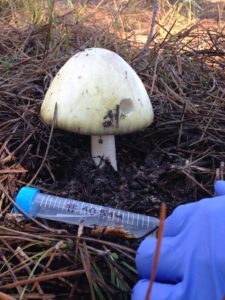
A photo in situ, meaning in place, can sometimes help you keep track of samples later.
2 Staying Organized: Take a photo of the mushroom in the soil, before collecting. To help you keep track of observations, it might help to place a notecard in the photo with a number of the mushroom. Using your phone to take this photo can also be an easy way to get the GPS point of your mushroom, even if you don’t have cell service.
3 Safe Handling: The death cap is deadly poisonous, but only if you eat it! The amatoxins can not be absorbed through the skin, but do remember to wash your hands thoroughly with soap and water after handling any death caps. Wearing latex or nitrile gloves can also reduce the risk of accidentally consuming toxic remnants. If you decide to dry the mushroom, wear goggles to protect your eyes, since dried mushrooms can be brittle and send small pieces flying.
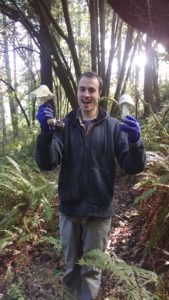
Photo: Fellow PhD student Nick Harris assists with an Amanita phalloides collecting trip. Remember, Citizens: safety is part of science!
4 Mushroom Collection: If you don’t have time to check for insect damage in the field, gently dig up the mushroom, making sure to collect all of the cup-like sac known as the volva. Place the mushroom in a wax or paper bag and tightly secure it in another bag or basket. A notecard, if used in 2., can go in this bag.
Since this is an invasive species in most parts of the world, we want to minimize the chance of moving Phalloides to new pristine environments. Try to avoid moving spores to new places by carefully bagging your specimens.
5 Slicing your mushroom: Within 8 hours of collecting the mushroom, use a clean knife to slice your mushroom in half vertically, from the top (cap) to the bottom (volva). (See the photo for 7).
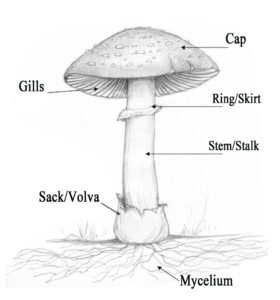
A simple diagram from http://www.yellowelanor.com/mushroom-identification-basics/
6 Assessing Insect Damage: Look for damage in each of the three mushroom compartments of interest, the Cap, Gills, and Stem.
0: no damage
1: minor damage
2: moderate damage
3: very damaged!
Below is an example of a damaged mushroom from this Mushroom Observer observation of another Amanita species, A. ocreata. From what we can see from Debbie’s photo, we categorize the damage as Cap: 2, Gills: 0, Stem: 2.
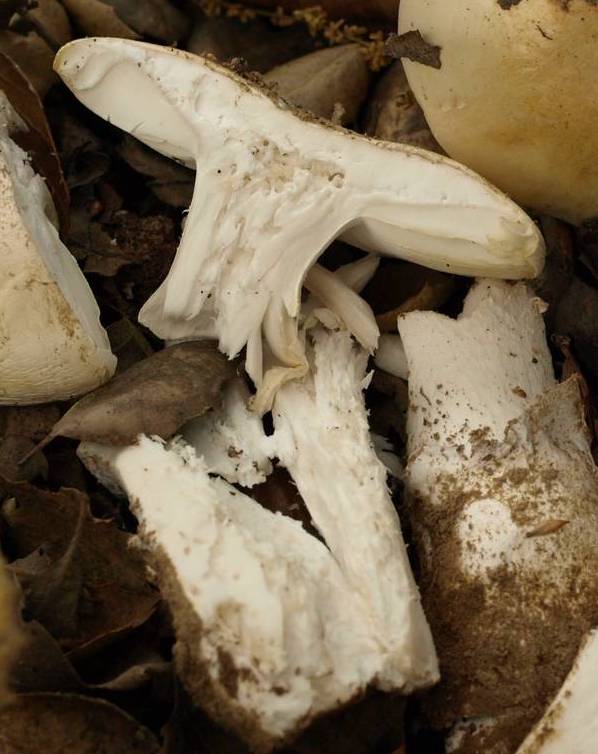
Photo credit: Debbie Veiss.
7 Photographing your Finds: Take at least one photograph of your mushroom like this, with some sort of ruler for scale:

Photo: Amanita arocheae in Costa Rica. This was a pristine sample with no damage in any compartment. It’s not great photo quality, but that’s why we ask for your damage assessment to compliment the photo!
Photograph your mushroom to the best of your ability, with the best camera and lighting you can muster. Not all photos will be of high enough quality for scientists to confirm your assessment, and that’s ok. When you see obvious insect damage, you can take a close up of the damage at the best angle you can. Don’t stress too much!
8 Data submission: Upload your photos and damage assessment to iNaturalist.
- Each submission will ideally contain: the mushroom’s location, a field photo (in situ), one or more photos of the sliced specimen, and (most importantly!) your assessment of insect damage.
- The website iNaturalist has a lot of useful guides to help beginners. Check out their help resources here: http://www.inaturalist.org/pages/help
9 Safe disposal: Amatoxins can NOT be neutralized with normal household boiling, freezing, heating, or baking. To effectively neutralize amatoxins, liberally spray or wipe 10% bleach on any tools or surfaces exposed to the mushroom. You can make up a 10% common household bleach solution by adding 9 parts of water to 1 part chlorine bleach (NaOCl). (Example: add 900 milliliters of water to 100 milliliters of household bleach.)
- If you are worried about animals or humans eating mushroom remnants, mash up the mushroom and soak the remnants in 10% bleach for 10 minutes. This mushroom mash can then be thrown away or flushed down a toilet or garbage disposal. However, do note that bleach may be harmful for the bacteria in septic tanks.
- Double bagging your mushroom waste can also minimize risk of consumption.
- To avoid spreading Phalloides spores to new locations, we encourage you to change your shoes after collecting death caps. Wash your collecting shoes before wearing them to a Phalloides-free area.
10 You’re done! Pat yourself on the back for contributing to science!
In the case of suspected consumption of Amanita phalloides or other mushrooms that may have amatoxins, contact your nearest poison control center immediately. Humans and dogs that are poisoned by amatoxins can be entered into a very promising clinical trial to treat amatoxin poisonings. Learn more about the clinical trial here: https://www.clinicaltrials.gov/ct2/show/study/NCT00915681
Tips on identifying mushrooms:
The best way to learn how to identify mushrooms is to learn from experts! Search for a mycological club in your area to learn about identifying mushrooms. You’ll get to go out into nature, exercise your body, learn to identify species, and make new friends!
The North American Mycological Association lists myco clubs in North America here: https://www.namyco.org/clubs.php
Phalloides ID for beginners:
Like other Amanita species, it’s very important to carefully dig up the whole specimen. Phalloides begins its mushroom stage as an ‘egg’, wrapped in a protective membrane called the universal veil that breaks apart as the mushroom expands. The sac at the bottom, called the volva, is very important for identification. Another membrane called the partial veil protects the gills until the spores are mature. The cap of the mushroom is usually olive green, sometimes with an almost metallic sheen. The color can vary a lot! There is a species variation known as ‘alba’ that can be pure white, so look for other distinguishing features to confirm your ID!
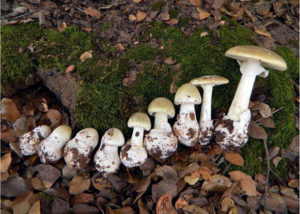
Photo: the Stages of Death by Justin Pierce. Note the universal veil on the button mushrooms to the left, and the partial veil below the gills on the right-most mushroom. The shape of the cap van vary greatly depending on the life stage of the mushroom.
The best resource to learn to identify mushrooms in the genus Amanita is this site run by Dr. Rod Tulloss, a world expert in Amanita: http://www.amanitaceae.org/
In the California Bay Area where Amanita phalloides is particularly common, Phalloides can strongly resemble A. gemmata, especially when the two are somewhat bleached from rain. Both can sometimes have patches of the universal veil remaining on the cap, so the volva is the distinguishing feature between these two species.
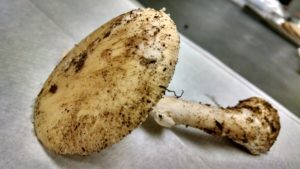
A pesky Amanita gemmata specimen from a site filled with death caps.
For Western US Mushroom hunters, Cat recommends the field guide “Mushrooms Demystified” by mushroom hunter extraordinaire David Arora to confirm your finds. “Mushrooms of the Redwood Coast” by Christian Schwarz and Noah Siegel has beautiful colored photographs that can aid in your mushroom identifying.
If you want more tips for identifying mushrooms in general, check out the website Mushroom Observer: http://mushroomobserver.org/
And read more about the death cap in this popular science article that Cat wrote for Slate.
Tips on observing and photographing fungi:
Some tips from iNaturalist on how to photograph mushrooms for identification: https://www.inaturalist.org/projects/fungi-of-the-california-floristic-province
A video guide by Christian Schwarz on photographing mushrooms: https://www.youtube.com/watch?v=LKF_pIY0Zpc
Learn from the experts! http://www.mushroomexpert.com/kuo_07.html
Some tips from another great fungi resource, Fungi Magazine: http://www.fungimag.com/winter-2013-articles/PhotoFocusLR.pdf
Top 10 Mistakes on Photographing Fungi: http://www.mushroomhobby.com/TOP_10_MISTAKES/
More on lighting: http://mushroom-collecting.com/mushroomphotography.html
Feedback:
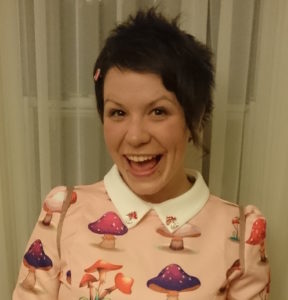
Mushrooms all the way down.
You can reach Cat via a number of ways:
- here in the blog comments
- on iNaturalist
- to Cat’s twitter account: @ScienceIsMetal
- or email her Berkeley address: catadams (at) berkeley (dot) edu







